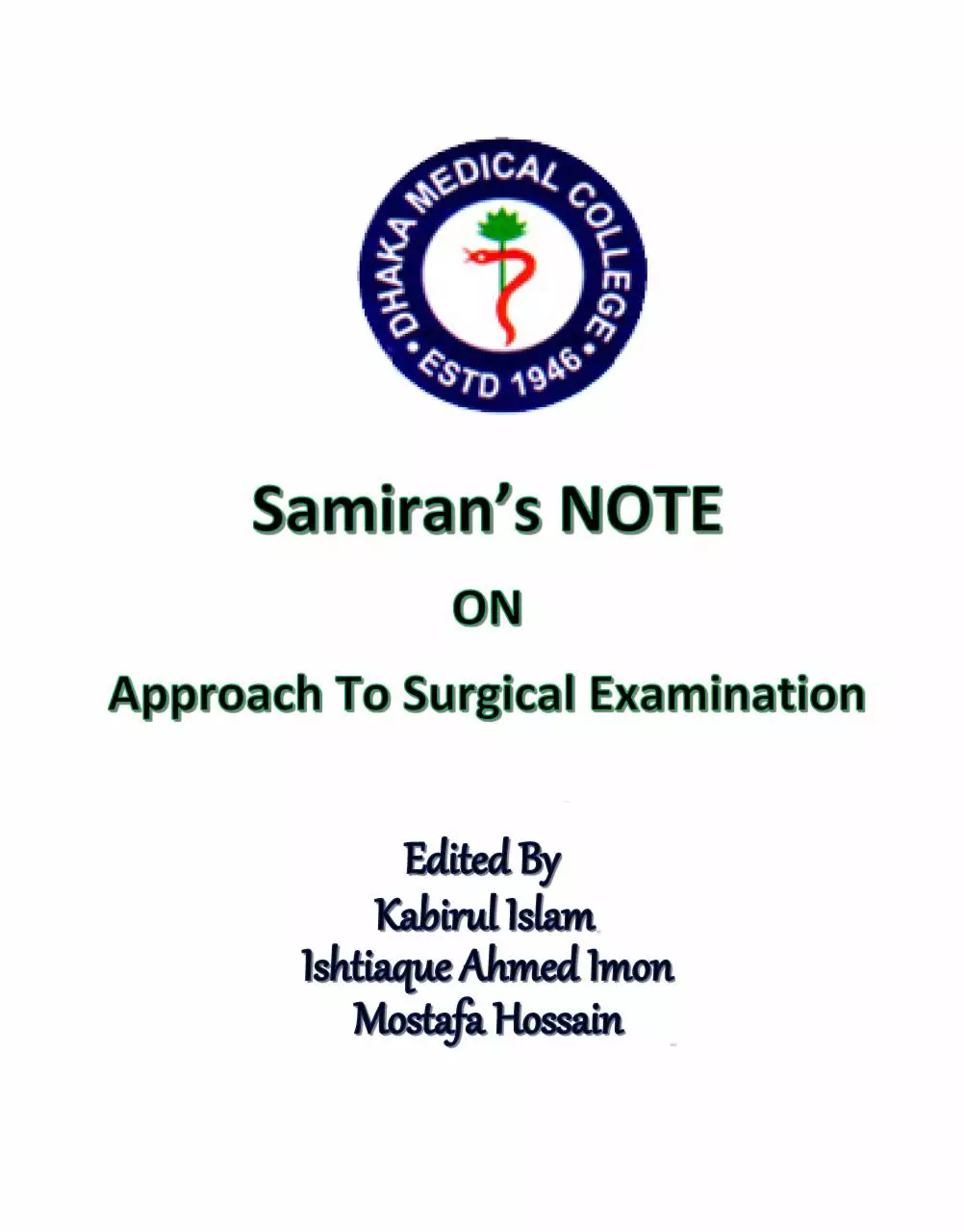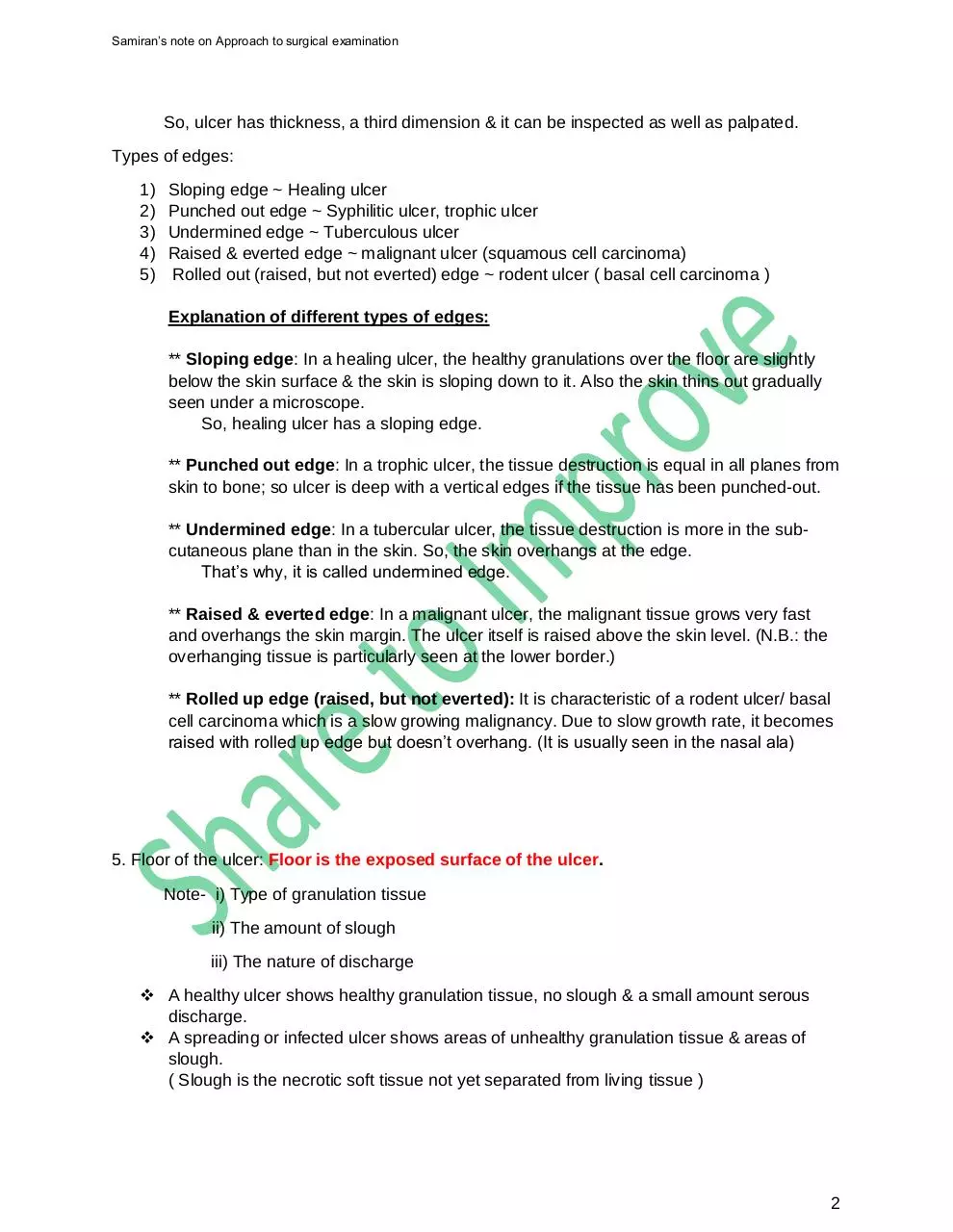Surgical Examination Protocol (PDF)
File information
Author: Samiran
This PDF 1.6 document has been generated by Microsoft® Word 2016, and has been sent on pdf-archive.com on 20/09/2016 at 08:32, from IP address 103.14.x.x.
The current document download page has been viewed 427 times.
File size: 2.21 MB (65 pages).
Privacy: public file





File preview
INDEX
Name
Page
Examination of an Ulcer
Examination of a Swelling
Examination of scrotal swelling
Examination of Inguino-Scrotal Swelling
Examination of an Abdominal lump
Examination of Breast Lump
Examination of a Thyroid Swelling
Peripheral Vascular Disease (PVD)
Examination of Varicose vein
01
07
15
19
25
35
41
50
56
Samiran’s note on Approach to surgical examination
Examination of an Ulcer
Inspection
1. Size & shape of ulcer:- measure the size in centimeters in two dimensions with a
measuring tape.
2. Number : Single or multiple.
3. Location of the ulcer.
Many ulcer have a characteristic site where they occur. For example:
i)
A varicose ulcer is located on the medial aspect of the lower third of the leg.
ii)
Rodent ulcer (An ulcerating basal cell carcinoma) are confined to an area of the
face above the line joining the angle of the mouth to the ear lobule.
iii)
Tuberculous ulcer are common in the neck over the sites of tubercular
lymphadenopathy.
iv)
An ulcer in a weight bearing area is usually a Trophic ulcer / Neuropathic ulcer
e.g. over the heels, over the sacrum & other bony points in a bed-ridden pt.
4. Margin & Edge of the ulcer.
Margin: Margin is the ‘border’ or ‘Transitional zone’ of the skin around the ulcer.
(It is the line demarcating the ulcer from the intact skin)
There are 3 types of margin:
i)
A healing ulcer shows typical bluish line of growing epithelium which is
squamous epithelium without cornification > Hence looks ‘Bluish’.
ii)
Inside this line, is the ‘red’ granulation tissue covered by a single layer of
epithelium which is transparent & shows the red color of the underlying
granulations.
iii)
And outside, it is the ‘white’ zone of newly cornified epithelium.
Margin of healing ulcer:
1. White ~ Outer
2. Blue ~ Central
3. Red ~ Inner
WBR
***A spreading ulcer shows a red, inflamed & irregular margin with inflamed surrounding
skin.
*** A chronic, non-healing ulcer shows marked fibrosis with thickened white skin margins
without the blue line of growing epithelium.
Edge: Edge is the mode of union/ junction between the floor & the margin of the ulcer.
1
Samiran’s note on Approach to surgical examination
So, ulcer has thickness, a third dimension & it can be inspected as well as palpated.
Types of edges:
1)
2)
3)
4)
5)
Sloping edge ~ Healing ulcer
Punched out edge ~ Syphilitic ulcer, trophic ulcer
Undermined edge ~ Tuberculous ulcer
Raised & everted edge ~ malignant ulcer (squamous cell carcinoma)
Rolled out (raised, but not everted) edge ~ rodent ulcer ( basal cell carcinoma )
Explanation of different types of edges:
** Sloping edge: In a healing ulcer, the healthy granulations over the floor are slightly
below the skin surface & the skin is sloping down to it. Also the skin thins out gradually
seen under a microscope.
So, healing ulcer has a sloping edge.
** Punched out edge: In a trophic ulcer, the tissue destruction is equal in all planes from
skin to bone; so ulcer is deep with a vertical edges if the tissue has been punched-out.
** Undermined edge: In a tubercular ulcer, the tissue destruction is more in the subcutaneous plane than in the skin. So, the skin overhangs at the edge.
That’s why, it is called undermined edge.
** Raised & everted edge: In a malignant ulcer, the malignant tissue grows very fast
and overhangs the skin margin. The ulcer itself is raised above the skin level. (N.B.: the
overhanging tissue is particularly seen at the lower border.)
** Rolled up edge (raised, but not everted): It is characteristic of a rodent ulcer/ basal
cell carcinoma which is a slow growing malignancy. Due to slow growth rate, it becomes
raised with rolled up edge but doesn’t overhang. (It is usually seen in the nasal ala)
5. Floor of the ulcer: Floor is the exposed surface of the ulcer.
Note- i) Type of granulation tissue
ii) The amount of slough
iii) The nature of discharge
A healthy ulcer shows healthy granulation tissue, no slough & a small amount serous
discharge.
A spreading or infected ulcer shows areas of unhealthy granulation tissue & areas of
slough.
( Slough is the necrotic soft tissue not yet separated from living tissue )
2
Samiran’s note on Approach to surgical examination
A chronic, non-healing ulcer shows pale, flat granulation tissue which does not bleed
easily on touch.
A large sized ulcer, where epithelialization is not completed in time shows hypertrophic
granulation tissue (exuberant granulation raising above the surface of the skin). This is
also termed as “Proud flesh”. It is accompanied by an excessive serosanguinous or
purulent discharge.
6. Inspection of the surrounding skin:
> If the ulcer is spreading & infected, the surrounding skin is shiny, red & edematous
due to cellulitis.
> Dark pigmentation & eczema surrounding the ulcer is typical in varicose ulcer i.e.
ulcer associated with varicose veins.
> Multiple scars & puckering of the skin surrounding the ulcer in the neck are
suggestive of tubercular ulcer.
> Hypopigmentation of surrounding skin is common in non-healing ulcer.
> Ulcer within the large scars suggests the possibility of a Marjolin’s ulcer (an ulcer
located over an old scar).
Revision Panel of Inspection of Ulcer
1) shape & size
2) Number
3) location
4) Margin
5) Edge
6) Floor
7) surrounding skin
3
Samiran’s note on Approach to surgical examination
Palpation
1. First palpate the surrounding skin for Temperature & Tenderness.
2. Then, wear gloves and palpate the ulcer: Its edge, floor & base.
3. Test the fixity of the ulcer to the structures in its base.
Procedure:
Begin the palpation by noting the temperature of the surrounding skin, palpating with the
back of the fingers & compare it with the opposite normal side.
Then note the tenderness over the surrounding area.
(Warmth & tenderness are suggestive of inflammation. They are seen in acutely
inflamed & spreading ulcers.)
Now palpate with a gloved hand over the edge & floor of the ulcer.
Edge: i) Soft = Healing ulcer
ii) Firm = Non-healing ulcer (due to Fibrosis)
iii) Hard = Malignant ulcer
Now palpate the granulation tissue over the floor & note whether it bleeds on touch.
A healthy granulation tissue shows pin-point hemorrhagic spots.
A malignant ulcer may bleed profusely (as seen in epithelioma over the scalp).
If there is slough over the floor, note whether the slough is attached loosely or
firmly.
Now palpate through the floor to note the consistency of the base & to note the
underlying structure whether it is a muscle, a fascia or a bone.
(Base: Base of an ulcer is the tissue on which the ulcer rests.)
If the ulcer is small, pinch it up & palpate the base between the fingers.
But if the ulcer is large, the base has to be felt over the floor of the ulcer with
gloved fingers.
All chronic ulcers have a firm base due to fibrosis.
But a hard feel or a marked induration should rise the suspicion of
malignancy.
Now try to move the ulcer from side to side in two different directions & note whether it is
fixed to the underlying structures.
If the ulcer is over a muscle mass, ask the patient to contract the muscle & test
the mobility again over the contracted muscle at right angles to the direction of
muscle fibers.
Reduced mobility implies fixity to the underlying muscles. This is the
Mobility Test.
4
Samiran’s note on Approach to surgical examination
Focal Examination
1. Regional lymph nodes
2. State of arteries, venous circulation & nerves ( depending on the type of ulcer)
3. Movement of the neighbouring joints.
Procedure:
1. Examination of regional lymph nodes:
Start with the palpation of regional lymph node groups.
If the regional lymph nodes are palpable, then palpate the higher group of lymph
nodes also.
Characteristics of lymph nodes:
i) Hard, discrete, non-tender ~ Malignant
ii) Soft, tender, enlarged ~ Infective
iii) Non-tender, matted ~ Tuberculous
2. Examination of related vessels & nerves :
If the ulcer is situated in the lower half of the leg, ask the patient to stand & look for
varicose veins. Examine the long & short saphenous veins & also look for scattered
& irregular varicosities which are more commonly associated with varicose ulcer.
If a varicose ulcer is suspected, also test for DVT by testing caff tenderness,
Homan’s sign, Mose’s sign. (Reference : Examination of varicose vein)
For every ulcer, anywhere on the leg, foot or over the hands, palpate all the related
arteries on both sides to rule out vascular disease & arterial insufficiency.
If the ulcer is located over the tips of the fingers or toes or over the dorsum of the
foot, then a detailed examination of the vascular system must be done (to rule out
the ischemic ulcer).
Then test the sensation of the skin surrounding the ulcer using a sharp pin. If the
sensations are diminished & particularly the ulcer is of trophic type over a pressure
bearing area, then the detailed neurological examination must be conducted.
Map the area of diminished sensation
Search features of leprosy
(Palpate posterior tibial, ulnar & greater auricular nerves for thickening as
observed in leprosy.)
Look for hypo-pigmented anesthetic patches over the limbs, back & face & also
look for features of Leonine Face.
And if a spinal cord lesion is suspected, test accordingly.
3. Examination of joints close to the ulcer:
Test the active & passive movements.
5
Samiran’s note on Approach to surgical examination
Restriction of movements of the joints indicates muscle or tendon involvement or a
painful inflammation.
Systemic Examination
1. CVS > for evidence of congestive cardiac failure which delays ulcer healing.
2. Respiratory System > For tuberculosis & secondaries
3. Alimentary system > for evidence of splenomegaly in Hemolytic anaemia in leg
ulcer.
------------------------------
6
Download Surgical Examination Protocol
Surgical Examination Protocol.pdf (PDF, 2.21 MB)
Download PDF
Share this file on social networks
Link to this page
Permanent link
Use the permanent link to the download page to share your document on Facebook, Twitter, LinkedIn, or directly with a contact by e-Mail, Messenger, Whatsapp, Line..
Short link
Use the short link to share your document on Twitter or by text message (SMS)
HTML Code
Copy the following HTML code to share your document on a Website or Blog
QR Code to this page

This file has been shared publicly by a user of PDF Archive.
Document ID: 0000484815.